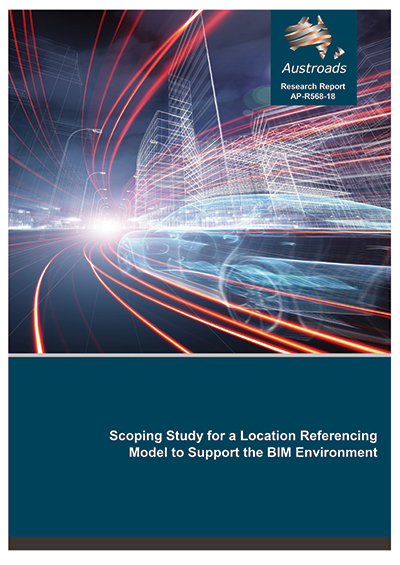Asset Management

- Publication no: AP-R568-18
- ISBN: 978-1-925671-55-1
- Published: 18 May 2018
- PDF (free) Download
An extensive review of location reference literature and direct enquiry within Australian and New Zealand road authorities, is aggregated into a new theoretical framework for location, location reference methods (LRM) and location referencing systems (LRS). This virtual location framework establishes location as independent of any single physical representation of location and associated location reference method families. Three families of LRM are described; topological, geospatial and geometric. Common elements of each family are: points, lines, paths and areas.
This project proposes a new Primary Location Reference System designed to support and to depend upon existing secondary reference systems and families of LRMs. The new system is an open standard location referencing method for horizontal network infrastructure. It is designed to support an Austroads Building Information Management (BIM) environment.
In the new system, a National Hub for Location Referencing would store each location as an independent virtual object. The system would be designed to facilitate information exchange using an extended OpenLRTM, the location reference method adopted by the European DATEX II standard.
- Summary
- Glossary of Terms
- 1. Introduction
- 1.1 Prior Work: Austroads Technical Report, AP-T190-11
- 1.2 Project Objective
- 1.3 Current Context and Directions in Location Referencing
- 1.3.1 Static Location Referencing Systems
- 1.3.2 Emerging Dynamic Systems
- 2. A New Theoretical Framework for Location
- 2.1 Location in Roads and Horizontal Infrastructure
- 2.1.1 Literature Review
- 2.2 Location Referencing
- 2.2.1 The Nature of Location
- 2.2.2 Location Reference (LR)
- 2.2.3 Location Reference Method (LRM)
- 2.2.4 Location Reference Systems (LRS)
- 2.1 Location in Roads and Horizontal Infrastructure
- 3. Families of Location Referencing Methods (LRMs)
- 3.1 Topological (Logical Linear and Network Referencing)
- 3.1.1 Linear Referencing
- 3.1.2 Network Referencing
- 3.1.3 Importance of Topological (Logical Linear and Network) Referencing
- 3.1.4 Relationship between Topological Reference Systems and Geospatial Coordinates
- 3.2 Geospatial (Real World Coordinates)
- 3.2.1 Open Geospatial Consortium: CityGML
- 3.2.2 Importance of Geospatial Referencing
- 3.3 Geometric (Model Coordinates)
- 3.3.1 buildingSmartInternational: IFC-Alignment
- 3.3.2 Open Geospatial Consortium LandInfra: Proposed Response for Geometric Data
- 3.3.3 Importance of Geometrical Referencing
- 3.1 Topological (Logical Linear and Network Referencing)
- 4. Integrating LRMs
- 4.1 Early Models for Integrated LRMs
- 4.2 Impact of Digital Design (BIM) on LRMs
- 5. Proposal for a New Primary LRS
- 5.1 Business Drivers for Location Reference Methods
- 5.2 The Concept of a Dominant Secondary LRM
- 5.3 An Alternative: Primary Location Reference System
- 5.3.1 DATEX II: http://www.datex2.eu/content/datex-background
- 5.3.2 OpenLRTM
- 5.4 Vertical Location Information
- 5.5 A National Location Reference Hub
- 5.5.1 Required Location Attributes
- 5.5.2 Levels of Detail Concepts
- 5.5.3 Application in Asset Management
- 6. Implementing Change
- 6.1 A Primary Location Referencing System
- 6.2 Integrating the Future
- 6.3 Proposed National Location Reference Hub
- 6.4 Influencing the Future
- References
- Appendix A Bibliography
- A.1 Linear and Spatial Standards
- A.2 Austroads Publications
- A.3 Working Papers from Individual Austroads Roads Jurisdictions
- A.4 Academic Papers
- A.4.1 Asset Management
- A.4.2 BIM & IFC
- A.4.3 Data & Technology
- A.4.4 Linear Referencing
- A.4.5 Modelling Location
- A.4.6 Networks and Level of Service
- A.4.7 Spatial Information Exchange
- A.5 Global Reports
